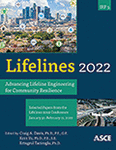Assessment of Protective Actions and Adjustments Taken by Shelter-in-Place Households Facing Disruptions in Critical Lifeline Services
Publication: Lifelines 2022
ABSTRACT
The research explores a dimension of preparedness against natural hazards by investigating disaster-induced service disruptions of critical lifelines. By using empirical survey data for regression modeling, the research establishes a methodological framework for examining protective actions and adjustments to service disruptions. Respondents were shelter-in-place households impacted by the power, water, and health facility disruptions caused by Hurricane Florence or Hurricane Michael in 2018. The study analyzes influencing factors such as sociodemographic characteristics, previous experience and expectation of service disruptions, and preparedness ability. Findings from regression models determined that number of protective actions were most influenced by expectation of power disruption, greater days of preparedness, and greater perception of preparedness, which emphasizes the importance of communicating and educating the community about preparedness measures. Additionally, socially vulnerable populations were associated with distinct adjustments such as selecting to tolerate the power disruption as opposed to leaving the residence or using a power generator.
Get full access to this article
View all available purchase options and get full access to this chapter.
REFERENCES
ATC (Applied Technology Council). (2016). Critical Assessment of Lifeline System Performance: Understanding Societal Needs in Disaster Recovery.
Baker, E. J. (2011). “Household preparedness for the Aftermath of Hurricanes in Florida.” Applied Geography.
Beatty, T. K. M., Shimshack, J. P., and Volpe, R. J. (2019). “Disaster preparedness and disaster response: Evidence from sales of emergency supplies before and after hurricanes.” Journal of the Association of Environmental and Resource Economists, 6(4).
Coleman, N., Esmalian, A., and Mostafavi, A. (2020). “Anatomy of susceptibility for shelter-in-place households facing infrastructure service disruptions caused by natural hazards.” International Journal of Disaster Risk Reduction, 50.
Dargin, J. S., and Mostafavi, A. (2020). “Human-centric infrastructure resilience: Uncovering well-being risk disparity due to infrastructure disruptions in disasters.” PLoS ONE, 15(6).
Flanagan, B. E., Gregory, E. W., Hallisey, E. J., Heitgerd, J. L., and Lewis, B. (2011). “A Social Vulnerability Index for Disaster Management.” Journal of Homeland Security and Emergency Management.
Fothergill, A., and Peek, L. A. (2004). “Poverty and disasters in the United States: A review of recent sociological findings.” Natural Hazards.
Horney, J. (2008). “Factors associated with hurricane preparedness: Results of a pre-hurricane assessment.” Journal of Disaster Research, 3(2).
Kapucu, N. (2008). “Culture of preparedness: Household disaster preparedness.” Disaster Prevention and Management: An International Journal.
Khan, S. U., Qureshi, M. I., Rana, I. A., and Maqsoom, A. (2019). “An empirical relationship between seismic risk perception and physical vulnerability: A case study of Malakand, Pakistan.” International Journal of Disaster Risk Reduction.
Lazo, J. K., Bostrom, A., Morss, R. E., Demuth, J. L., and Lazrus, H. (2015). “Factors Affecting Hurricane Evacuation Intentions.” Risk Analysis.
Lindell, M. K., and Perry, R. W. (2012). “The Protective Action Decision Model: Theoretical Modifications and Additional Evidence.” Risk Analysis.
Lizarralde, G., Valladares, A., Olivera, A., Bornstein, L., Gould, K., and Barenstein, J. D. (2015). “A systems approach to resilience in the built environment: The case of Cuba.” Disasters.
Martins, V. N., Nigg, J., Louis-Charles, H. M., and Kendra, J. M. (2019). “Household preparedness in an imminent disaster threat scenario: The case of superstorm sandy in New York City.” International Journal of Disaster Risk Reduction.
Masozera, M., Bailey, M., and Kerchner, C. (2007). “Distribution of impacts of natural disasters across income groups: A case study of New Orleans.” Ecological Economics.
Sattler, D. N., Kaiser, C. F., and Hittner, J. B. (2000). “Disaster preparedness: Relationships among prior experience, personal characteristics, and distress.” Journal of Applied Social Psychology.
Sutton, J. N., and Tierney, K. (2006). Disaster Preparedness: Concepts, Guidance, and Research. Boulder, University of Colorado Natural Hazards Center, Institute of Behavioral Science.
Information & Authors
Information
Published In
History
Published online: Nov 16, 2022
Authors
Metrics & Citations
Metrics
Citations
Download citation
If you have the appropriate software installed, you can download article citation data to the citation manager of your choice. Simply select your manager software from the list below and click Download.
